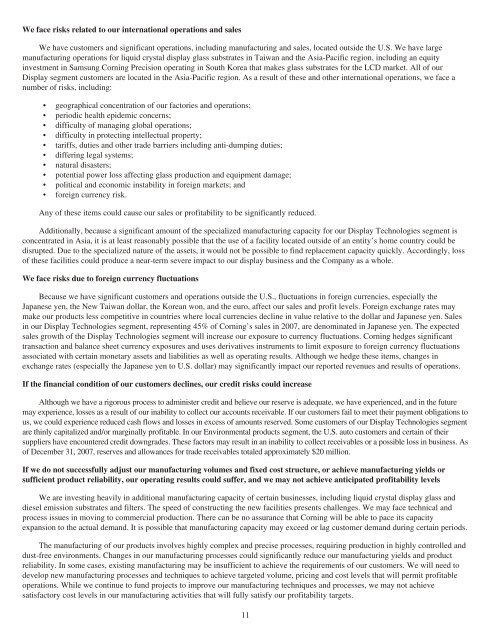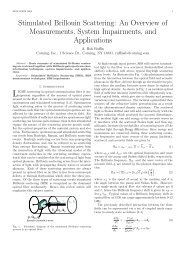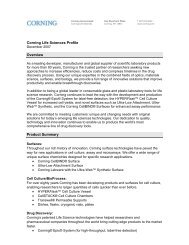You also want an ePaper? Increase the reach of your titles
YUMPU automatically turns print PDFs into web optimized ePapers that Google loves.
We face risks related to our international operations and sales<br />
We have customers and significant operations, including manufacturing and sales, located outside the U.S. We have large<br />
manufacturing operations for liquid crystal display glass substrates in Taiwan and the Asia-Pacific region, including an equity<br />
investment in Samsung <strong>Corning</strong> Precision operating in South Korea that makes glass substrates for the LCD market. All of our<br />
Display segment customers are located in the Asia-Pacific region. As a result of these and other international operations, we face a<br />
number of risks, including:<br />
• geographical concentration of our factories and operations;<br />
• periodic health epidemic concerns;<br />
• difficulty of managing global operations;<br />
• difficulty in protecting intellectual property;<br />
• tariffs, duties and other trade barriers including anti-dumping duties;<br />
• differing legal systems;<br />
• natural disasters;<br />
• potential power loss affecting glass production and equipment damage;<br />
• political and economic instability in foreign markets; and<br />
• foreign currency risk.<br />
Any of these items could cause our sales or profitability to be significantly reduced.<br />
Additionally, because a significant amount of the specialized manufacturing capacity for our Display Technologies segment is<br />
concentrated in Asia, it is at least reasonably possible that the use of a facility located outside of an entity’s home country could be<br />
disrupted. Due to the specialized nature of the assets, it would not be possible to find replacement capacity quickly. Accordingly, loss<br />
of these facilities could produce a near-term severe impact to our display business and the Company as a whole.<br />
We face risks due to foreign currency fluctuations<br />
Because we have significant customers and operations outside the U.S., fluctuations in foreign currencies, especially the<br />
Japanese yen, the New Taiwan dollar, the Korean won, and the euro, affect our sales and profit levels. Foreign exchange rates may<br />
make our products less competitive in countries where local currencies decline in value relative to the dollar and Japanese yen. Sales<br />
in our Display Technologies segment, representing 45% of <strong>Corning</strong>’s sales in <strong>2007</strong>, are denominated in Japanese yen. The expected<br />
sales growth of the Display Technologies segment will increase our exposure to currency fluctuations. <strong>Corning</strong> hedges significant<br />
transaction and balance sheet currency exposures and uses derivatives instruments to limit exposure to foreign currency fluctuations<br />
associated with certain monetary assets and liabilities as well as operating results. Although we hedge these items, changes in<br />
exchange rates (especially the Japanese yen to U.S. dollar) may significantly impact our reported revenues and results of operations.<br />
If the financial condition of our customers declines, our credit risks could increase<br />
Although we have a rigorous process to administer credit and believe our reserve is adequate, we have experienced, and in the future<br />
may experience, losses as a result of our inability to collect our accounts receivable. If our customers fail to meet their payment obligations to<br />
us, we could experience reduced cash flows and losses in excess of amounts reserved. Some customers of our Display Technologies segment<br />
are thinly capitalized and/or marginally profitable. In our Environmental products segment, the U.S. auto customers and certain of their<br />
suppliers have encountered credit downgrades. These factors may result in an inability to collect receivables or a possible loss in business. As<br />
of December 31, <strong>2007</strong>, reserves and allowances for trade receivables totaled approximately $20 million.<br />
If we do not successfully adjust our manufacturing volumes and fixed cost structure, or achieve manufacturing yields or<br />
sufficient product reliability, our operating results could suffer, and we may not achieve anticipated profitability levels<br />
We are investing heavily in additional manufacturing capacity of certain businesses, including liquid crystal display glass and<br />
diesel emission substrates and filters. The speed of constructing the new facilities presents challenges. We may face technical and<br />
process issues in moving to commercial production. There can be no assurance that <strong>Corning</strong> will be able to pace its capacity<br />
expansion to the actual demand. It is possible that manufacturing capacity may exceed or lag customer demand during certain periods.<br />
The manufacturing of our products involves highly complex and precise processes, requiring production in highly controlled and<br />
dust-free environments. Changes in our manufacturing processes could significantly reduce our manufacturing yields and product<br />
reliability. In some cases, existing manufacturing may be insufficient to achieve the requirements of our customers. We will need to<br />
develop new manufacturing processes and techniques to achieve targeted volume, pricing and cost levels that will permit profitable<br />
operations. While we continue to fund projects to improve our manufacturing techniques and processes, we may not achieve<br />
satisfactory cost levels in our manufacturing activities that will fully satisfy our profitability targets.<br />
11







